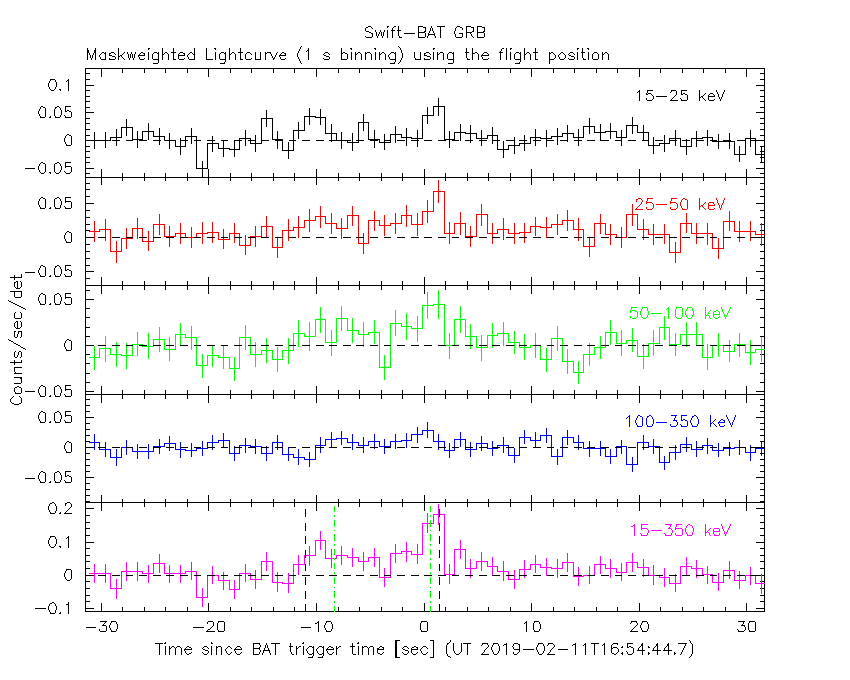
F.E. Marshall (NASA/GSFC) and P.A. Evans (U. Leicester) for the Swift team
At 16:54:44 UT, the Swift Burst Alert Telescope (BAT) triggered and located GRB 190211A (trigger=888648) (Marshall et al. GCN Circ. 23883). Swift slewed after a short delay to the burst. At the time of the trigger, the initial BAT position was 127° from the Sun (8.5 hours West) and 125° from the 37%-illuminated Moon. Table 1 contains the best reported positions from Swift, and the latest XRT position can be viewed at http://www.swift.ac.uk/xrt_positions.
Xu et al. (GCN Circ. 23884) reported the position for the optical afterglow of this GRB. Marshall (GCN Circ. 23894) reported the detection with UVOT of an optical afterglow. Table 2 is a summary of GCN Circulars about this GRB from observatories other than Swift.
Standard analysis products for this burst are available at https://gcn.gsfc.nasa.gov/swift_gnd_ana.html.
As reported by Stamatikos et al. (GCN Circ. 23887),
the BAT ground-calculated position is RA, Dec = 196.652, 41.976 deg which is RA(J2000) = 1
The mask-weighted light curve (Figure 1) shows a a pair of peaks, the first from T-12 to T-5 s, and the second from T-4 to T+2 s.
The time-averaged spectrum from T-11.49 to T+1.66 s is best fit by a simple power-law model.
The power law index of the time-averaged spectrum is 1.51 ± 0.33.
The fluence in the 15-150 keV band is 6.5 ± 1.2 x 1
The results of the batgrbproduct analysis are available at https://gcn.gsfc.nasa.gov/notices_s/888648/BA/.
Analysis of the initial XRT data was reported by Evans et al. (GCN Circ. 23888). We have analysed 22 ks of XRT data for GRB 190211A, from 205 s to 271.2 ks after the BAT trigger. The data are entirely in Photon Counting (PC) mode.
The light curve (Figure 2) can be modelled with an initial power-law decay with an index of α=0.13 (+0.25, -0.18), followed by a break at T+1099 s to an α of 1.16 (+0.07, -0.04).
A spectrum formed from the PC mode data can be fitted with an absorbed power-law with a photon spectral index of 1.93 (+0.11, -0.10). The best-fitting absorption column is 6.9 (+2.6, -2.4) x 1
A summary of the PC-mode spectrum is thus:
Total column: 6.9 (+2.6, -2.4) x 1
Galactic foreground: 1.7 x 1
Excess significance: 3.6 σ
Photon index: 1.93 (+0.11, -0.10)
The results of the XRT team automatic analysis are available at http://www.swift.ac.uk/xrt_products/00888648.
The Swift/UVOT began settled observations of the field of GRB 190211A 203 s after the BAT trigger
(Marshall GCN Circ. 23894).
A source consistent with the optical position (Xu et al. GCN Circ. 23884) and just outside the 90% confidence XRT position (Evans et al. GCN Circ. 23888) is detected in the only UVOT exposure.
Table 3 gives preliminary
magnitudes using the UVOT photometric system
(Breeveld et al. 2011, AIP Conf. Proc., 1358, 373).
No correction has been made for the expected extinction in the Milky Way
corresponding to a reddening of

Figure 1. The BAT
mask-weighted light curve in the four individual and total
energy bands. The units are counts

Figure 2. The XRT light curve.
Any data from a crosshatched region are not included in the fit.
| RA (J2000) | Dec (J2000) | Error | Note | Reference |
|---|---|---|---|---|
| 1 |
+41°58'04.9" | 0.53" | UVOT-refined | Marshall GCN Circ. 23894 |
| 1 |
+41°58'01.5" | 3.5" | XRT-final | UKSSDC |
| 1 |
+41°58'01.5" | 3.5" | XRT-refined | Evans et al. GCN Circ. 23888 |
| 1 |
+41°58'32.1" | 2.3' | BAT-refined | Stamatikos et al. GCN Circ. 23887 |
| Band | Authors | GCN Circ. | Subject | Observatory | Notes |
|---|---|---|---|---|---|
| Optical | Xu et al. | 23884 | NEXT-0.6m optical afterglow detection | Xinjiang Astro. Obs. | detection |
| Optical | Lipunov et al. | 23885 | MASTER Global Robotic Net optical observation |
MASTER | |
| Optical | Hu et al. | 23886 | BOOTES-4/MET optical afterglow confirmation |
BOOTES-4 | detection |
| Optical | Heintz et al. | 23890 | NOT optical observations | NOT | detection |
| Optical | Oeda et al. | 23891 | MITSuME Akeno optical observation | MITSuME Akeno | |
| Optical | Paek et al. | 23893 | DOAO optical observation | DOAO | detection |
| Optical | Stecklum and Klose | 23895 | Tautenburg observations | Tautenburg | detection |
| Optical | Kumar et al. | 23896 | GROWTH-India detection of optical afterglow |
GROWTH-India | detection |
| Filter | Exp(s) | Mag | ||
|---|---|---|---|---|
| white | 203 | 351 | 146 | 19.73 ± 0.11 |
Table 3. UVOT observation reported by Marshall (GCN Circ. 23894). The start and stop time of the exposure are given in seconds since the BAT trigger. The preliminary detection is given. No correction has been made for extinction in the Milky Way.
February 15, 2019